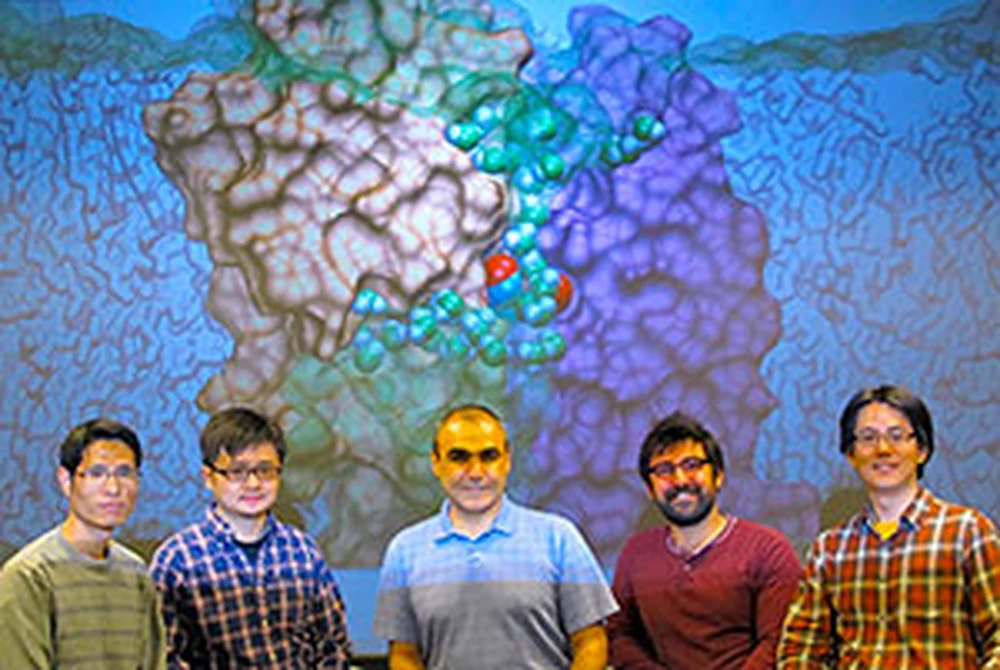
Associate Professor of Biochemistry Emad Tajkhorshid and colleagues have discovered a new mechanism by which water channel proteins in cell membranes allow water molecules to flow easily while keeping protons out. The research appears in the journal Science.
The cell membrane serves as a protective barrier that lets only certain materials in or out of the cell, helping to maintain an environment conducive to cellular processes. There are many types of proteins embedded in the cell membrane that control which molecules can pass through, said University of Illinois biochemistry professor Emad Tajkhorshid, whose lab conducted the collaborative research with colleagues at the University of Gothenburg in Sweden.
Tajkhorshid’s lab studies aquaporins, proteins responsible for water transport across the membrane. Aquaporins allow water molecules to pass through, but exclude protons which are even smaller in size, Tajkhorshid said. The selective abilities of aquaporins have great physiological importance, he said.
“The proton gradient across the membrane is a source of energy for the cell; it’s almost like a battery for the cell, so if there are leaks, protons can go through too fast and kill the cell. But at the same time, you want to allow water to go through,” Tajkhorshid said. “That’s one of the results of millions of years of evolution: to come up with a channel that is so specific for one or two types of molecules, but nothing else.”
Normally, protons “hop” from one water molecule to the next. Tajkhorshid compares this process to the behavior of a toy known as Newton’s cradle. When the metallic ball on a string on one end of a Newton’s cradle is lifted and released, it crashes into a line of other metallic balls on strings, transferring the force through the line and propelling the last ball outward. This is analogous to a proton crashing into a line of water molecules, Tajkhorshid said.
“One proton comes in, jumps on the first water molecule, but because that water already has two protons on it, it receives that one proton, then gives one of its protons to the next water. Then the next water gives this extra proton to the next water molecule,” he said. “This series of proton hops between seven or eight water molecules effectively results in the release of a proton from the other end.”
Researchers used the highest-resolution crystal structure of a membrane protein ever solved to see some of the tiny hydrogen bonds within the protein, and they discovered yet another mechanism the aquaporin uses to stifle proton transport.
After the chain of water molecules enters the pore, it passes through the narrowest region (called the selectivity filter), causing the water molecules to remain, as Tajkhorshid said, “strictly single file.” This results in a “high correlation between the water molecules’ motions in the selectivity filter,” he said.
“We used molecular dynamics simulations to show how the atoms interact with each other and what forces are acting between them to predict the trajectory of each atom. We saw that the highest correlation between two neighboring water molecules is in the selectivity filter. That means they move together like they are connected to each other tightly,” Tajkhorshid said.
These correlational measures show that the two water molecules in this narrow passage behave differently than those in the rest of the chain above and below this region, Tajkhorshid said.
“Outside the selectivity filter, you have a nice chain of water molecules moving together – a little playful but still moving together. But then you come to this high fit region, where these two water molecules are moving together but at the cost of becoming isolated from the others,” Tajkhorshid said. “When they pass this region, they rejoin the calmer chain of water molecules.”
The breaking of the water molecule chain stops the characteristic proton hopping, keeping the protons from going through the aquaporin but allowing water through.
This newly discovered mechanism joins a host of previously discovered mechanisms that are evolutionarily advantageous to the cell, Tajkhorshid said.
“Nature has evolved this protein system with multiple selectivity mechanisms working together. Cells with only one mechanism have the potential to fail, but if they have two or three complementary mechanisms working together, then they ensure that protons are strongly excluded,” he said.